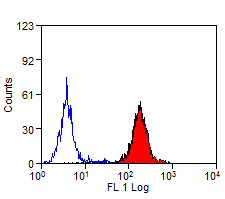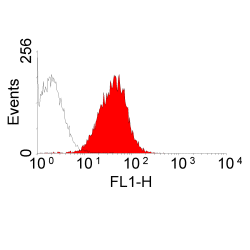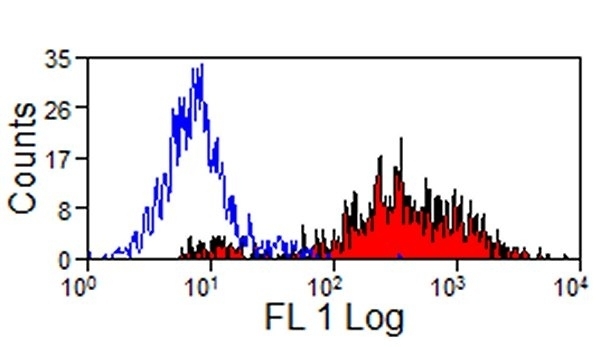IgG antibody






Goat anti Mouse IgG:FITC (Rat Adsorbed)
- Product Type
- Polyclonal Antibody
- Isotype
- Polyclonal IgG
- Specificity
- IgG
| Goat anti Mouse IgG antibody recognizes mouse IgG. The reagent has been adsorbed to minimise cross-reactivity with rat immunoglobulins and is therefore of particular value in detecting mouse primary antibodies bound to rat tissues. Goat IgG shows minimal binding to Fc receptors on rat tissue. We recommend diluting this product in buffer containing 10% normal rat serum to remove any residual cross-reactivity. |
- Target Species
- Mouse
- Product Form
- Purified IgG conjugated to Fluorescein Isothiocyanate Isomer 1 (FITC) - liquid
- Antiserum Preparation
- Antisera to mouse IgG were raised by repeated immunisation of goats with highly purified antigen. Purified IgG was prepared by affinity chromatography.
- Buffer Solution
- Phosphate buffered saline
- Preservative Stabilisers
0.09% Sodium Azide 1% Bovine Serum Albumin - Immunogen
- Mouse IgG.
- Approx. Protein Concentrations
- IgG concentration 0.5 mg/ml
- Max Ex/Em
-
Fluorophore Excitation Max (nm) Emission Max (nm) FITC 490 525 - Regulatory
- For research purposes only
- Guarantee
- 12 months from date of despatch
Avoid repeated freezing and thawing as this may denature the antibody. Storage in frost-free freezers is not recommended. This product is photosensitive and should be protected from light.
| Application Name | Verified | Min Dilution | Max Dilution |
|---|---|---|---|
| Flow Cytometry | 1/50 | 1/200 |
- Flow Cytometry
- Use 50ul of the suggested working dilution to label 106 cells in 100ul.
References for IgG antibody
-
Voulgaraki, D. et al. (2005) Multivalent recombinant proteins for probing functions of leucocyte surface proteins such as the CD200 receptor.
Immunology. 115 (3): 337-46. -
Gibbings, D.J. et al. (2007) CD8α is expressed by human monocytes and enhances FcγR-dependent responses.
BMC Immunol. 8: 12. -
Win, T.S. et al. (2009) Donor CD4 T cells contribute to cardiac allograft vasculopathy by providing help for autoantibody production.
Circ Heart Fail. 2 (4): 361-9. -
Fitzgerald, A.M. et al. (2012) The effects of transforming growth factor-β2 on the expression of follistatin and activin A in normal and glaucomatous human trabecular meshwork cells and tissues.
Invest Ophthalmol Vis Sci. 53 (11): 7358-69. -
Conlon, T.M. et al. (2012) Germinal center alloantibody responses are mediated exclusively by indirect-pathway CD4 T follicular helper cells.
J Immunol. 188 (6): 2643-52. -
Motallebzadeh, R. et al. (2012) Blocking lymphotoxin signaling abrogates the development of ectopic lymphoid tissue within cardiac allografts and inhibits effector antibody responses.
FASEB J. 26 (1): 51-62. -
Chen, F. et al. (2015) Generation of B Cell-Deficient Pigs by Highly Efficient CRISPR/Cas9-Mediated Gene Targeting.
J Genet Genomics. 42 (8): 437-44. -
Harper, I.G. et al. (2016) Augmentation of Recipient Adaptive Alloimmunity by Donor Passenger Lymphocytes within the Transplant.
Cell Rep. 15 (6): 1214-27.
View The Latest Product References
-
Naaldijk, Y. et al. (2017) Effect of systemic transplantation of bone marrow-derived mesenchymal stem cells on neuropathology markers in APP/PS1 Alzheimer mice.
Neuropathol Appl Neurobiol. 43 (4): 299-314. -
Strazielle, N. et al. (2016) T-Lymphocytes Traffic into the Brain across the Blood-CSF Barrier: Evidence Using a Reconstituted Choroid Plexus Epithelium.
PLoS One. 11 (3): e0150945. -
Tyrsina, E. et al. (2019) Detection and quantification of VEGFR-1 in the nuclei of tumor cells by a new flow cytometry-based method.
J Immunotoxicol. 16 (1): 74-81. -
Niedżwiedzka-Rystwej, P. et al. (2020) B and T lymphocytes in rabbits change according to the sex and throughout the year.
Pol J Vet Sci. 23 (1): 37-42.
- RRID
- AB_321914
- UniProt
- P01869
- P01865
- P01864
- P01868
- P03987
- P01867
- P01863
- Entrez Gene
- Igh-1a
- Igh-1a
- Igh-1a
- Ighg2b
- Ighg1
- Ighg1
- AI324046
- GO Terms
- GO:0003823 antigen binding
- GO:0002455 humoral immune response mediated by circulating immunoglobulin
- GO:0019731 antibacterial humoral response
- GO:0042571 immunoglobulin complex, circulating
- GO:0005886 plasma membrane
- GO:0016021 integral to membrane
- GO:0005576 extracellular region
- GO:0001788 antibody-dependent cellular cytotoxicity
- GO:0001798 positive regulation of type IIa hypersensitivity
- View More GO Terms
- GO:0001812 positive regulation of type I hypersensitivity
- GO:0006910 phagocytosis, recognition
- GO:0006911 phagocytosis, engulfment
- GO:0006958 complement activation, classical pathway
- GO:0050766 positive regulation of phagocytosis
STAR70
If you cannot find the batch/lot you are looking for please contact our technical support team for assistance.
Please Note: All Products are "FOR RESEARCH PURPOSES ONLY"
View all Anti-Mouse ProductsAlways be the first to know.
When we launch new products and resources to help you achieve more in the lab.
Yes, sign me up




